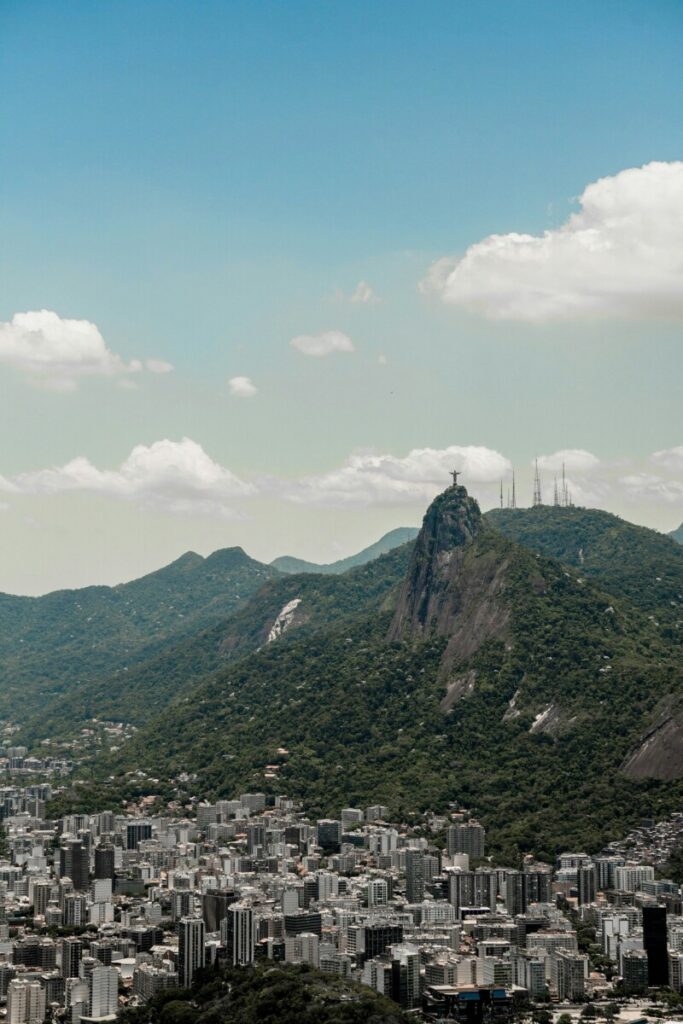Undoubtedly, many countries have monuments or iconic landmarks that are impossible to miss. Added to this is the cultural richness of each location, making them popular destinations throughout the year.
When we think of Brazil, many things come to mind: its delicious cuisine (which we already discussed in a previous blog entry), its dances, vibrant colors, breathtaking landscapes, and the warmth of its people…
And, of course, the famous figure of Christ the Redeemer.
Today, we’ll share a bit about its history and meaning.

Christ the Redeemer is much more than a giant statue of Jesus, it is also one of the modern wonders of the world. Located at the top of Mount Corcovado in Rio de Janeiro, within the Tijuca National Park (an urban tropical forest), it’s a globally recognized symbol for Christians and a national icon.
The statue stands 38 meters tall, including an 8-meter pedestal, and the span of its extended arms is 28 meters. The estimated weight of the statue is 635 tons, as it is made of reinforced concrete. Its outer layer is crafted from soapstone, a soft and weather-resistant rock. The statue is located 710 meters above sea level.
The initial proposal for a religious statue on Mount Corcovado dates back to 1859, by priest Pedro Maria Boss. However, the project did not move forward at that time. In 1921, the Catholic Circle of Rio promoted the construction of the monument as part of the celebrations for Brazil’s centenary of independence.
The main architect was Heitor da Silva Costa, while the design was created by sculptor Paul Landowski. Construction began in 1926 and was completed five years later, in 1931. The statue was inaugurated on October 12 of that year, coinciding with the feast day of Our Lady of Aparecida, Brazil’s patron saint.
The construction utilized an innovative system for the time, blending modern engineering with ancient and artistic techniques.
Christ the Redeemer symbolizes peace, welcoming, and divine love for humanity. It is also an emblem of Brazilian cultural identity and hospitality.
As such a popular site, it attracts pilgrims and tourists throughout the year for meditation and prayer. It’s estimated that around 2 million people visit Christ the Redeemer annually, making it one of Brazil’s most popular tourist attractions. Visitors come from all over the world to enjoy the panoramic views of the city and admire the statue’s majesty. The peak visitor periods often coincide with Brazil’s high tourism seasons, especially during Rio’s Carnival, summer holidays (December to February), and religious festivities like Holy Week and the feast of Our Lady of Aparecida (October 12).
In 2007, it was declared one of the New Seven Wonders of the Modern World.
Accessing Christ the Redeemer can be done via trains (Trem do Corcovado), tourist buses, or hiking trails. Once at the top, escalators and elevators are available to ensure access for everyone.
In addition to the incredible city views, visitors are treated to breathtaking vistas of Guanabara Bay, Sugarloaf Mountain, and Copacabana Beach.
Due to constant exposure to severe and changing weather conditions, regular maintenance is carried out to repair cracks and restore the soapstone coating. A major restoration in 2010 included cleaning, waterproofing, and the installation of new LED lighting. Lightning rods have also been installed, as the statue’s height makes it a frequent lightning target. In 2014, a lightning strike damaged one of the statue’s fingers, which led to its immediate restoration.

Some Interesting Facts
- This statue has appeared in numerous movies and international events, further increasing its global fame.
- It is considered one of the most Instagrammed locations in the world.
- It was designed to be visible from any point in the city, symbolizing the presence of Christ over all of Rio de Janeiro.
- The construction was made possible by the financial contributions of thousands of Brazilian faithful. The fundraising campaign was organized by the Catholic Church.
- Although it seems completely upright, the statue has a slight forward tilt, designed to give the impression that it is embracing the city.
- Christ the Redeemer has inspired the construction of similar statues in other countries, such as the Christ of the Concord in Bolivia and Christ the King in Poland.

Brazil awaits you, ready to amaze you at every turn!



